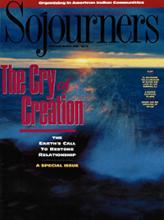NBC Nightly News' report "Tragedy at Pine Ridge" prompted angry reactions from Lakota people involved with the South Dakota Indian reservation that was the subject of the Thanksgiving week series. The three-part report, they contend, focused exclusively on the negative aspects of life at Pine Ridge and portrayed the reservation as being little more than a collection of garbage piles and run-down houses inhabited only by welfare mothers, alcoholics, and victims of fetal alcohol syndrome.
People at Pine Ridge are concerned that the series left viewers with the impression that the Lakota people themselves are not doing anything to fight these problems. The first part of the series gave an overview of the problems that come with 85 percent unemployment and 85 percent alcoholism. The second part focused on fetal alcohol syndrome, caused when women drink while they are pregnant. The last in the series profiled one Lakota youngster in order to show the effects of reservation problems on children.
NBC chose to leave out stories of people who are working and having success in solving some of the problems portrayed in the series. In phone interviews, M.L. Flynn, the producer, and Betty Rollin, the reporter, defended their series, saying limited air time gave them the opportunity to provide only "snapshots" of what life is like for the average reservation dweller. Flynn spent months, she says, researching the story by phone and in person and believes the three-part series is "fair and honest."
"There are a lot of good people there [at Pine Ridge]," Rollin said. "I understand their reaction. Nevertheless, I think it was journalistically responsible to go this way with the series." The few positive steps reservation people are taking, according to Rollin, were not enough to justify giving NBC viewers a sense that there is much hope for change at Pine Ridge.
Read the Full Article
